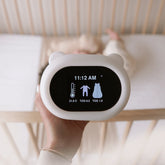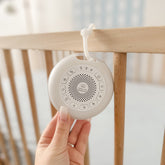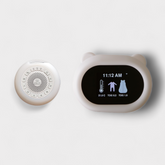A white noise machine for your baby can be a game-changer for new parents, helping little ones drift off to sleep and stay asleep longer by masking unpredictable environmental noises. By mimicking the familiar, constant sounds of the womb, white noise is a simple, effective tool for better sleep.
But how do you use a white noise machine the right way? Safety and correct usage are key. Here is your essential guide based on expert advice.
- Part 1: Safe Sleep Setup of White Noise Machine
- Part 2: What to Look For When Buying a Baby White Noise Machine
- Part 3: Safety Standards & Why They Matter
- Part 4: FAQ
Part 1: Safe Baby White Noise Machine Setup (Volume & Placement)
The most important aspect of using any white noise machine for babies is ensuring it is safe and effective through proper placement and volume control.
1. Optimal Placement and Distance
Distance acts as a buffer and is crucial for protecting your baby's hearing.
- Maintain Distance: You should keep your baby white noise machine at least a meter (three feet) or more away from the baby's cot or bassinet.
- Never Inside the Crib: Do not under any circumstances place the white noise machine inside your baby’s cot or bassinet. Place the machine where you intend for it to stay and measure the sound from there.
2. Getting the Volume Right
A white noise machine for your baby is only effective and safe when the volume is appropriate. Too loud, and it can be harmful; too quiet, and it won't block noises.
- Measure at the Source: Use a free decibel meter app on your phone to check the volume.
- Test at Baby's Position: Crucially, do not measure the volume right next to the machine. Place your phone inside the cot or bassinet—right where your baby's head would be—to get an accurate reading.
- Target Decibel Level: Aim for the sound level at the baby's ear to be around or under 50 decibels (dB). This is roughly comparable to the hum of a quiet refrigerator, a gentle rain shower, or a hushed conversation.
3. When to use for maximum benefit
Baby white noise machines are best used at the beginning of a sleep period to help settle your baby - try to avoid leaving it on all the time as it can increase dependence.
Some devices include a timer function which can be especially useful if you'd like to reduce the likelihood of your baby becoming dependent on white noise to sleep.
@infantsleepaustralia
Setting the volume of your baby white noise machine
Part 2: What to Look For When Buying a Baby White Noise Machine
When shopping for the best baby white noise machine, focus on features that maximise consistency and safety, not complexity.
| Key Feature | Why It's Essential for Babies |
| Simple Sound Profile | Choose a machine that generates a sound similar to "rushing air" or simple static like white/pink noise. These sounds are best for blocking background noise and mimicking the in-utero environment. Other sounds like nature, water etc. are nice-to-have but not essential. |
| Easily Adjustable Volume | Since you must precisely control the volume to stay under 50 dB, the machine needs a simple, reliable way to adjust the output level. |
| Portability | A portable white noise machine for babies is invaluable for travel or consistency when your baby sleeps in different spots. It ensures the familiar sleep cue is always present, giving you some ability to control the environment. |
| Power / Battery Life | Battery operated is great, but if you plan to use your device both inside the nursery as well as on-the-go keep an eye out for a device that will run WHILE BEING CHARGED - this is not typical for most cheaper devices. Another tip is to look for a battery life at least twice as long as the longest sleep window you can imagine (eg 24+ hours), as battery life typically degrades over time. |
| Safety Standards | This is an important one - buying a cheapie no-name brand off eBay/Amazon may sound like a good idea at the time, but often these devices don't adhere to the relevant safety standards in Australia/New Zealand (if they have been tested at all). Buyer beware. |
Part 3: Safety Standards & Why They Matter
When purchasing a portable white noise machine for your baby you'll want to ensure it meets at least the minimum safety standards for sale in Australia - keep in mind that online marketplaces typically do nothing to enforce minimum safety standards.
Here is a list of some of the standards to consider for portable baby white noise machines:
| Safety Standard | Why It's Important |
| AS/NZS 62368.1 | Safety requirements for electronic equipment - BARE MINIMUM |
| AS/NZS 60598.1/2 | Luminaries - ensuring the mechanical/electrical integrity and thermal management of the lights of the device |
| AS/NZS 62471 | Photobiological safety testing - ensuring the light levels and colours are safe for prolonged use |
| AS/NZS 4268 | Radio equipment testing - important for devices that might have wireless capabilities |
For example, our Sound Sleeper Portable Baby White Noise Machine with its rich feature set, red light, long battery life has been tested against all electronic equipment safety and light safety standards mentioned in the table above.
Part 4: FAQ
Is pink noise or white noise best for babies?
Pink noise is suggested to be more familiar and soothing for newborns because the sounds in the womb fall into the pink/red noise spectrum, whereas white noise effectively masks sudden, jarring external noises like a barking dog or slamming door.
Why is red light recommended for babies?
Red light's long wavelength is key. Unlike blue or white light, it does not trigger the photoreceptors in the eye that signal the brain to suppress melatonin production, helping the baby (and parents) return to sleep faster.
What are the best features for portable white noise machines for babies?
Look for a device with long battery life, the ability to operate while charged, both white and pink noise, and if it has a light function it should be red light.
What is a safe volume for baby white noise machines?
50dB is the highest recommended safe volume for babies - this is roughly comparable to the hum of a quiet refrigerator, a gentle rain shower, or a hushed conversation.
Should I get a battery or plug-in baby white noise machine for my baby?
If you're looking for an all-in-one device keep an eye out for a unit that can run while being plugged in, like our Sound Sleeper Portable White Noise Machine For Babies.














